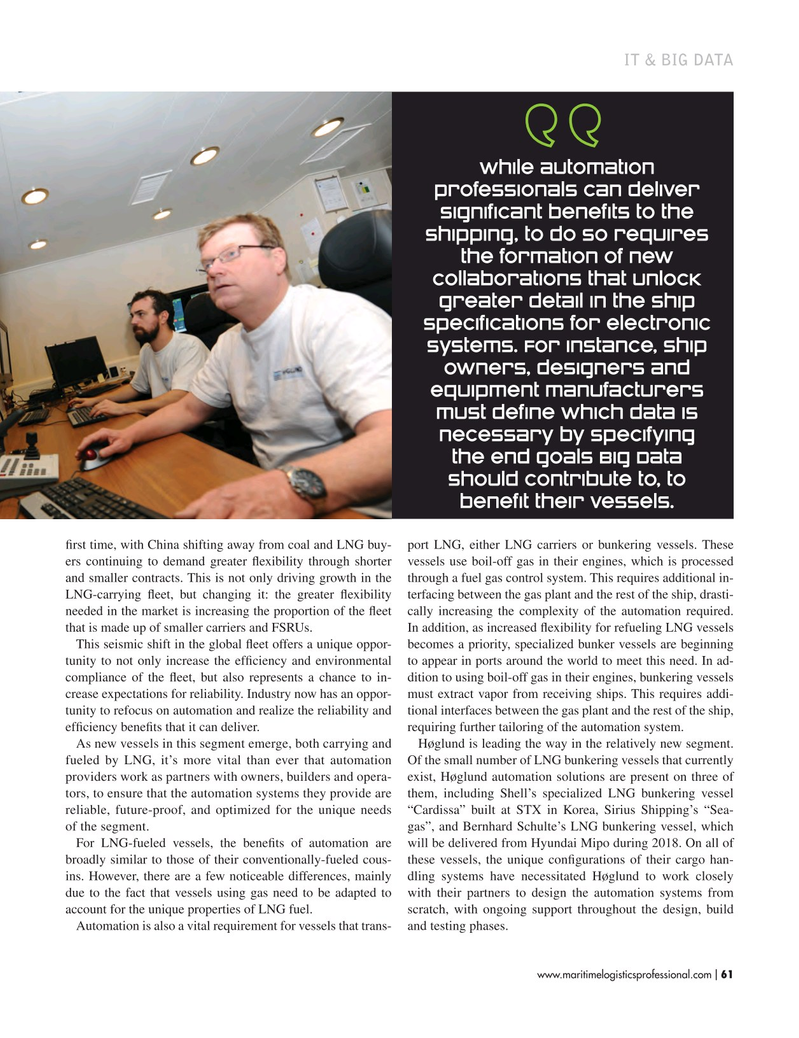
Page 61: of Maritime Logistics Professional Magazine (Mar/Apr 2018)
IT & Software
Read this page in Pdf, Flash or Html5 edition of Mar/Apr 2018 Maritime Logistics Professional Magazine
IT & BIG DATA
While automation professionals can deliver significant benefits to the shipping, to do so requires the formation of new collaborations that unlock greater detail in the ship specifications for electronic systems. For instance, ship owners, designers and equipment manufacturers must define which data is necessary by specifying the end goals Big Data should contribute to, to benefit their vessels.
frst time, with China shifting away from coal and LNG buy- port LNG, either LNG carriers or bunkering vessels. These ers continuing to demand greater fexibility through shorter vessels use boil-off gas in their engines, which is processed and smaller contracts. This is not only driving growth in the through a fuel gas control system. This requires additional in-
LNG-carrying feet, but changing it: the greater fexibility terfacing between the gas plant and the rest of the ship, drasti- needed in the market is increasing the proportion of the feet cally increasing the complexity of the automation required. that is made up of smaller carriers and FSRUs. In addition, as increased fexibility for refueling LNG vessels
This seismic shift in the global feet offers a unique oppor- becomes a priority, specialized bunker vessels are beginning tunity to not only increase the effciency and environmental to appear in ports around the world to meet this need. In ad- compliance of the feet, but also represents a chance to in- dition to using boil-off gas in their engines, bunkering vessels crease expectations for reliability. Industry now has an oppor- must extract vapor from receiving ships. This requires addi- tunity to refocus on automation and realize the reliability and tional interfaces between the gas plant and the rest of the ship, effciency benefts that it can deliver. requiring further tailoring of the automation system.
As new vessels in this segment emerge, both carrying and Høglund is leading the way in the relatively new segment. fueled by LNG, it’s more vital than ever that automation Of the small number of LNG bunkering vessels that currently providers work as partners with owners, builders and opera- exist, Høglund automation solutions are present on three of tors, to ensure that the automation systems they provide are them, including Shell’s specialized LNG bunkering vessel reliable, future-proof, and optimized for the unique needs “Cardissa” built at STX in Korea, Sirius Shipping’s “Sea- of the segment. gas”, and Bernhard Schulte’s LNG bunkering vessel, which
For LNG-fueled vessels, the benefts of automation are will be delivered from Hyundai Mipo during 2018. On all of broadly similar to those of their conventionally-fueled cous- these vessels, the unique confgurations of their cargo han- ins. However, there are a few noticeable differences, mainly dling systems have necessitated Høglund to work closely due to the fact that vessels using gas need to be adapted to with their partners to design the automation systems from account for the unique properties of LNG fuel. scratch, with ongoing support throughout the design, build
Automation is also a vital requirement for vessels that trans- and testing phases.
www.maritimelogisticsprofessional.com 61
I

 60
60

 62
62
